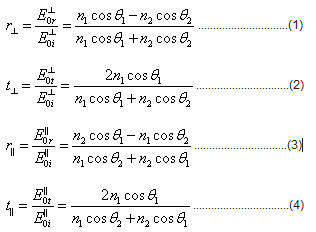Fresnel's Equations
Fresnel's equations: Fresnel's equation relates the ratio of the amplitude of the electric field of reflected and transmitted light to that of the incident field, angle of incidence and the refractive indices of two media forming the interface. Let us denote the amplitude of incident electric field in the plane of incidence as  and that of nomal to the plane of incidence as
and that of nomal to the plane of incidence as  . Accordingly the reflected and transmitted amplitude of electric fields are:
. Accordingly the reflected and transmitted amplitude of electric fields are:
 Amplitude of the parallel component of electric field transmitted.
Amplitude of the parallel component of electric field transmitted.
 Amplitude of the normal component of electric field reflected.
Amplitude of the normal component of electric field reflected.
The ratio of the reflected amplitude to that of the incidence amplitude is called as amplitude reflected coefficient r ( ![]() or
or ![]() , for corresponding to parallel or normal component respectively) and that of for transmitted component is called as amplitude transmitted coefficent (
, for corresponding to parallel or normal component respectively) and that of for transmitted component is called as amplitude transmitted coefficent ( ![]() and
and ![]() ). The expressions for these coefficients are given by
). The expressions for these coefficients are given by

These four equations are called as Fresnel's equations and can be obtained by solving the wave propagation equations under the appropriate boundary conditions ((Ref: D.J. Griffiths, Introduction to Electromagnatics, Prentice Hall(1995). ).
The ratio of corresponding reflected (transmitted) intensity to the incidence intensity is called as the reflectivity (transmittance) for the interface.
Thus,
